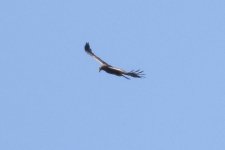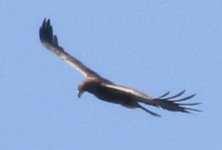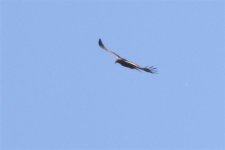A local non birder with broken english told me there were many eagles in Lubrin , Almeria including Spanish Imperial Eagles. So the plan was a quick look around the local swamp then a trip to Lubrin Via Bedar.
Problem was I left my bins on the car roof at the swamp only realising when I got to Bedar where there were 2 golden eagles circling the rocky outcrops.
At Lubrin We saw 4 large eagles some distance way, 3 were identified as young golden eagles and the fourth circling on its own a short distance away from the other three was captured in a rather poor photo which shows considerable white along the inner leading edge. It appeared as large as the smallest of the 3 goldens which was notably smaller than the other 2 but difficult to be sure.
The question is was it a Spanish Imperial. Having not seen one before, opinions would be appreciated. I have seen many golden eagles over the years in Scotland and Spain.
I think the white on the wings may be just reflection from the very strong sun and there does not appear to be any white on the shoulders.
Thanks
Karl
Problem was I left my bins on the car roof at the swamp only realising when I got to Bedar where there were 2 golden eagles circling the rocky outcrops.
At Lubrin We saw 4 large eagles some distance way, 3 were identified as young golden eagles and the fourth circling on its own a short distance away from the other three was captured in a rather poor photo which shows considerable white along the inner leading edge. It appeared as large as the smallest of the 3 goldens which was notably smaller than the other 2 but difficult to be sure.
The question is was it a Spanish Imperial. Having not seen one before, opinions would be appreciated. I have seen many golden eagles over the years in Scotland and Spain.
I think the white on the wings may be just reflection from the very strong sun and there does not appear to be any white on the shoulders.
Thanks
Karl








